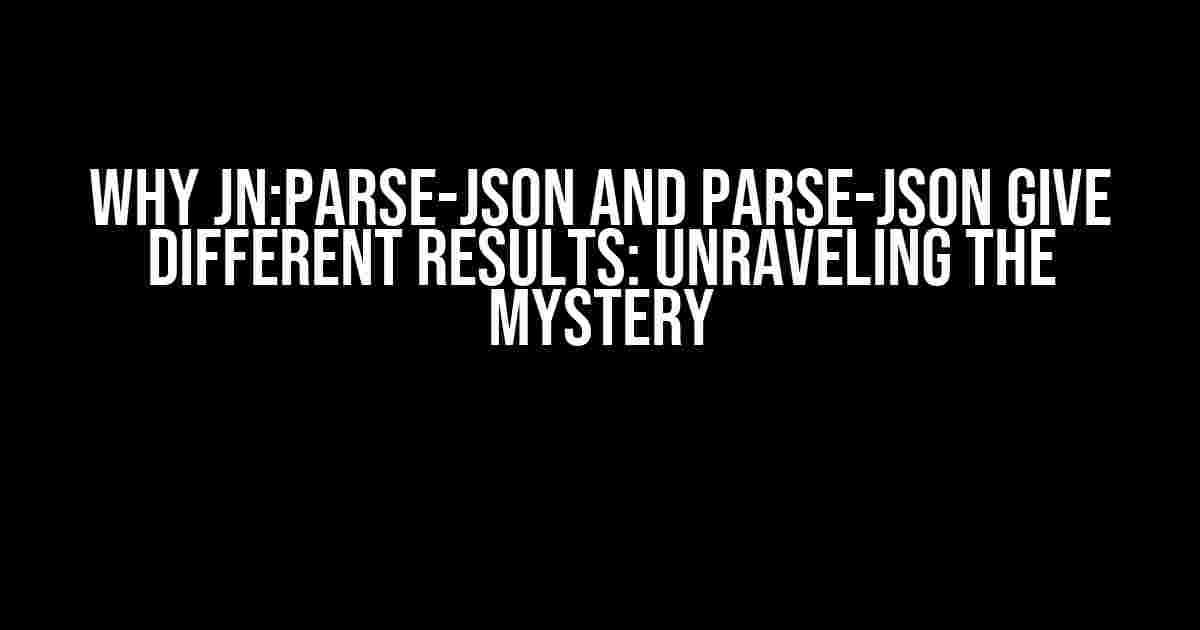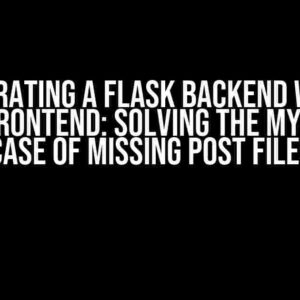Are you tired of scratching your head, wondering why jn:parse-json and parse-json seem to produce different results? You’re not alone! Many developers have stumbled upon this enigmatic issue, only to be left in the dark. Fear not, dear reader, for we’re about to shed some light on this perplexing problem. In this article, we’ll delve into the world of JSON parsing, explore the differences between jn:parse-json and parse-json, and provide you with a comprehensive guide on how to tackle this confounding conundrum.
The Origins of the Problem: A Brief History of JSON Parsing
JSON (JavaScript Object Notation) has become the de facto standard for data exchange between web servers, web applications, and mobile apps. With its simplicity and ease of use, JSON has revolutionized the way we handle data. However, as with any powerful tool, comes great responsibility – and sometimes, great confusion.
In the early days of JSON, parsing libraries emerged to help developers handle this new format. Two popular libraries, Jackson and JSON.NET, became the go-to choices for many developers. jn:parse-json and parse-json, respectively, were born from these libraries, each with their own strengths and weaknesses.
The Difference Between jn:parse-json and parse-json
So, what’s the main difference between these two JSON parsing functions? The answer lies in their underlying architecture and design principles.
jn:parse-json: The Jackson Way
jn:parse-json, hailing from the Jackson library, is known for its flexibility and customization options. This parser is built with performance and scalability in mind, making it a popular choice for large-scale applications. jn:parse-json uses a streaming approach, where JSON data is parsed incrementally, allowing for efficient processing of large datasets.
One of jn:parse-json’s unique features is its ability to handle complex data structures, such as Jackson’s @JsonView annotation, which enables flexible filtering of JSON data.
@JsonView(UserView.class)
public class User {
private String firstName;
private String lastName;
private List<Address> addresses;
// getters and setters
}
In this example, the @JsonView annotation allows jn:parse-json to selectively serialize only the fields specified in the UserView class, making it possible to tailor the output to specific use cases.
parse-json: The JSON.NET Way
parse-json, on the other hand, is a part of the JSON.NET library, which is known for its ease of use and high-performance parsing capabilities. This parser is designed to be highly configurable, with a focus on flexibility and customization.
parse-json uses a DOM (Document Object Model) approach, where the entire JSON document is loaded into memory before being parsed. This allows for easy navigation and manipulation of the JSON data.
JsonSerializer serializer = new JsonSerializer();
User user = serializer.Deserialize<User>(jsonString);
In this example, parse-json deserializes the JSON string into a User object using the JsonSerializer class.
Why jn:parse-json and parse-json Give Different Results
So, why do these two JSON parsing functions produce different results? The answer lies in their underlying parsing strategies and design principles.
Performance and Scalability
jn:parse-json, with its streaming approach, is generally faster and more scalable than parse-json, which uses a DOM approach. This means that jn:parse-json is better suited for large datasets and high-performance applications.
However, this performance comes at the cost of flexibility. jn:parse-json’s strict parsing rules can lead to errors when dealing with malformed JSON data.
Flexibility and Customization
parse-json, on the other hand, provides more flexibility and customization options, making it easier to handle complex data structures and edge cases. Its DOM approach allows for more control over the parsing process, but at the cost of performance and scalability.
parse-json’s lax parsing rules can lead to errors when dealing with malformed JSON data, but its ability to handle complex data structures makes it a popular choice for many developers.
Real-World Examples and Scenarios
Let’s explore some real-world examples and scenarios where jn:parse-json and parse-json produce different results.
Example 1: Handling Malformed JSON Data
Suppose we have a JSON string with a missing closing bracket:
{
"name": "John",
"age": 30
jn:parse-json would throw an error when attempting to parse this malformed JSON data, whereas parse-json would attempt to parse the data, potentially leading to errors or unexpected results.
Example 2: Handling Complex Data Structures
Suppose we have a JSON string with a complex data structure, such as an array of objects:
[
{
"name": "John",
"age": 30
},
{
"name": "Jane",
"age": 25
}
]
parse-json would struggle to handle this complex data structure, whereas jn:parse-json would parse the data correctly, thanks to its streaming approach.
Best Practices and Workarounds
So, how can we work around these differences and ensure our JSON parsing functions produce consistent results? Here are some best practices and workarounds to keep in mind:
-
Validate your JSON data: Before parsing your JSON data, validate it using a JSON validator to ensure it conforms to the JSON specification.
-
Choose the right parser for the job: Depending on your specific use case, choose the parser that best fits your needs. If you’re dealing with large datasets, jn:parse-json might be a better choice. If you need to handle complex data structures, parse-json might be more suitable.
-
Use a JSON parsing library with a flexible configuration: Consider using a JSON parsing library that provides flexible configuration options, such as custom deserializers or serializers, to tailor the parsing process to your specific needs.
-
Test and debug thoroughly: Thoroughly test and debug your JSON parsing code to ensure it produces consistent results and handles edge cases correctly.
Conclusion
In conclusion, the differences between jn:parse-json and parse-json stem from their underlying design principles and parsing strategies. By understanding these differences and following best practices and workarounds, you can ensure that your JSON parsing functions produce consistent results and handle complex data structures with ease.
Remember, the choice between jn:parse-json and parse-json ultimately depends on your specific use case and requirements. By choosing the right parser for the job and following best practices, you’ll be well on your way to mastering the art of JSON parsing.
| Parser | Parsing Strategy | Performance | Flexibility |
|---|---|---|---|
| jn:parse-json | Streaming | High | Medium |
| parse-json | DOM | Medium | High |
Now, go forth and conquer the world of JSON parsing! If you have any questions or need further clarification, feel free to ask in the comments below.
Here is the HTML code for 5 Questions and Answers about “Why jn:parse-json and parse-json give different results”:
Frequently Asked Question
Are you tired of getting different results from jn:parse-json and parse-json? Worry no more! We’ve got the answers to your burning questions.
Question 1: What is the main difference between jn:parse-json and parse-json?
The main difference lies in how they handle JSON parsing. jn:parse-json is a vendor-prefixed function that uses the Jsoniq parsing engine, whereas parse-json is a standard XQuery function that uses the XQuery parsing engine. This difference in parsing engines can lead to varying results.
Question 2: Why do jn:parse-json and parse-json produce different results for the same JSON input?
It’s because of the different parsing engines used. Jsoniq is more strict about JSON syntax and error handling, whereas XQuery is more lenient. This means that jn:parse-json might throw an error for a JSON input that parse-json would accept, and vice versa.
Question 3: Can I rely on parse-json for parsing JSON data?
While parse-json is a standard XQuery function, it’s not recommended to rely solely on it for parsing JSON data. The XQuery parsing engine has limitations and may not always produce accurate results, especially for complex JSON structures. It’s always best to use jn:parse-json for more reliable and accurate parsing.
Question 4: How can I ensure consistent results between jn:parse-json and parse-json?
To ensure consistent results, always use jn:parse-json for parsing JSON data. If you must use parse-json, make sure to validate your JSON input thoroughly beforehand. You can also use tools like JSON validators to ensure your input is correct and error-free.
Question 5: Are there any plans to standardize JSON parsing in XQuery?
Yes, there are ongoing efforts to standardize JSON parsing in XQuery. The XQuery Working Group is working on a new specification for JSON parsing that will provide a more reliable and consistent way of parsing JSON data. However, until then, it’s best to stick with jn:parse-json for accurate and reliable JSON parsing.




